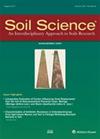The role of geochemistry in organic carbon stabilization against microbial decomposition in tropical rainforest soils
4区 农林科学
Q2 Agricultural and Biological Sciences
引用次数: 22
Abstract
Abstract. Stabilization of soil organic carbon (SOC) against microbial decomposition depends on several soil properties, including the soil weathering stage and the mineralogy of parent material. As such, tropical SOC stabilization mechanisms likely differ from those in temperate soils due to contrasting soil development. To better understand these mechanisms, we investigated SOC dynamics at three soil depths under pristine tropical African mountain forest along a geochemical gradient from mafic to felsic and a topographic gradient covering plateau, slope and valley positions. To do so, we conducted a series of soil C fractionation experiments in combination with an analysis of the geochemical composition of soil and a sequential extraction of pedogenic oxides. Relationships between our target and predicting variables were investigated using a combination of regression analyses and dimension reduction. Here, we show that reactive secondary mineral phases drive SOC properties and stabilization mechanisms together with, and sometimes more strongly than, other mechanisms such as aggregation or C stabilization by clay content. Key mineral stabilization mechanisms for SOC were strongly related to soil geochemistry, differing across the study regions. These findings were independent of topography in the absence of detectable erosion processes. Instead, fluvial dynamics and changes in soil moisture conditions had a secondary control on SOC dynamics in valley positions, leading to higher SOC stocks there than at the non-valley positions. At several sites, we also detected fossil organic carbon (FOC), which is characterized by high C/N ratios and depletion of N. FOC constitutes up to 52.0 ± 13.2 % of total SOC stock in the C-depleted subsoil. Interestingly, total SOC stocks for these soils did not exceed those of sites without FOC. Additionally, FOC decreased strongly towards more shallow soil depths, indicating decomposability of FOC by microbial communities under more fertile conditions. Regression models, considering depth intervals of 0–10, 30–40 and 60–70 cm, showed that variables affiliated with soil weathering, parent material geochemistry and soil fertility, together with soil depth, explained up to 75 % of the variability of SOC stocks and Δ14C. Furthermore, the same variables explain 44 % of the variability in the relative abundance of C associated with microaggregates vs. free-silt- and-clay-associated C fractions. However, geochemical variables gained or retained importance for explaining SOC target variables when controlling for soil depth. We conclude that despite long-lasting weathering, geochemical properties of soil parent material leave a footprint in tropical soils that affects SOC stocks and mineral-related C stabilization mechanisms. While identified stabilization mechanisms and controls are similar to less weathered soils in other climate zones, their relative importance is markedly different in the tropical soils investigated.地球化学在热带雨林土壤有机碳稳定与微生物分解中的作用
摘要土壤有机碳(SOC)抗微生物分解的稳定性取决于几种土壤性质,包括土壤风化阶段和母质矿物学。因此,由于土壤发育的差异,热带土壤有机碳稳定机制可能与温带土壤不同。为了更好地理解这些机制,我们研究了原始热带非洲山地森林下三个土壤深度的有机碳动态,沿地球化学梯度从基性到长质,地形梯度覆盖高原、斜坡和山谷位置。为此,我们进行了一系列土壤C分馏实验,并结合土壤地球化学成分分析和成土氧化物的顺序提取。我们的目标变量和预测变量之间的关系是用回归分析和降维相结合的方法来研究的。在这里,我们发现反应性次生矿物相与其他机制(如粘土含量的聚集或碳稳定)一起驱动有机碳性质和稳定机制,有时比其他机制更强烈。土壤有机碳的关键矿物稳定机制与土壤地球化学密切相关,在不同研究区域存在差异。这些发现与地形无关,因为没有可检测到的侵蚀过程。相反,河流动力和土壤湿度条件的变化对山谷位置的有机碳动态具有次要控制作用,导致山谷位置的有机碳储量高于非山谷位置。有机碳(FOC)具有较高的C/N比和N的损耗特征,FOC占失碳底土总有机碳储量的52.0±13.2%。有趣的是,这些土壤的总有机碳储量没有超过没有FOC的土壤。此外,FOC向较浅的土壤深度强烈减少,表明微生物群落在更肥沃的条件下分解FOC。考虑0-10、30-40和60-70 cm深度区间的回归模型表明,土壤风化、母质地球化学和土壤肥力以及土壤深度相关的变量解释了高达75%的有机碳储量变异andΔ14C。此外,同样的变量解释了与微团聚体相关的碳相对丰度与自由淤泥和粘土相关的碳组分相对丰度的44%的变异性。然而,在控制土壤深度时,地球化学变量对解释有机碳目标变量具有重要意义。我们得出结论,尽管长期风化,土壤母质的地球化学性质在热带土壤中留下足迹,影响有机碳储量和矿物相关的碳稳定机制。虽然已确定的稳定机制和控制与其他气候带较少风化的土壤相似,但其相对重要性在所调查的热带土壤中明显不同。
本文章由计算机程序翻译,如有差异,请以英文原文为准。
求助全文
约1分钟内获得全文
求助全文
来源期刊

Soil Science
农林科学-土壤科学
CiteScore
2.70
自引率
0.00%
发文量
0
审稿时长
4.4 months
期刊介绍:
Cessation.Soil Science satisfies the professional needs of all scientists and laboratory personnel involved in soil and plant research by publishing primary research reports and critical reviews of basic and applied soil science, especially as it relates to soil and plant studies and general environmental soil science.
Each month, Soil Science presents authoritative research articles from an impressive array of discipline: soil chemistry and biochemistry, physics, fertility and nutrition, soil genesis and morphology, soil microbiology and mineralogy. Of immediate relevance to soil scientists-both industrial and academic-this unique publication also has long-range value for agronomists and environmental scientists.
 求助内容:
求助内容: 应助结果提醒方式:
应助结果提醒方式:


